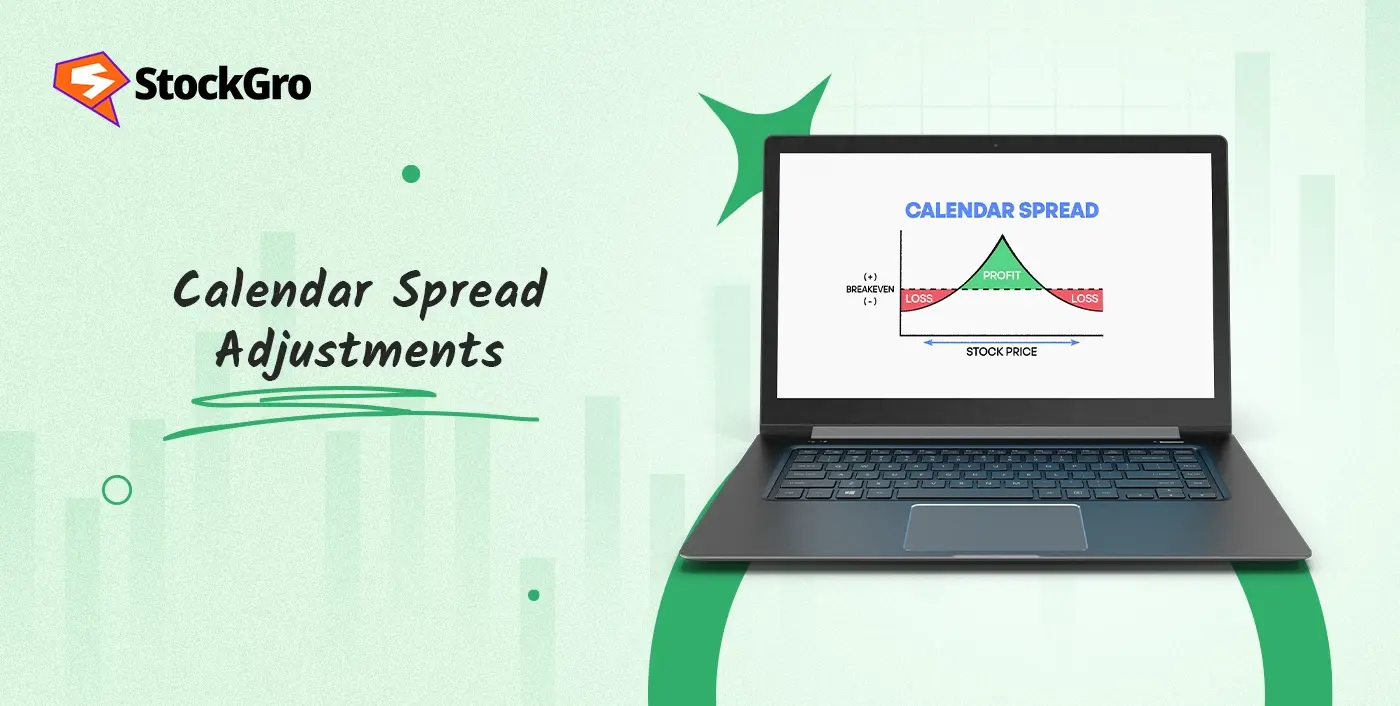
One of the trickiest problems with calendar spreads is managing the impact of uneven time decay between the short and long options legs, especially when market conditions shift unexpectedly. This imbalance can cause losses even when the underlying price stays stable. Calendar spread adjustments provide a solution by helping traders rebalance their positions and guard against the hidden erosion that time decay disparities can cause. In this blog, we discuss how these adjustments can protect your trades and improve your chances of success.
Calendar Spread Adjustments
A calendar spread adjustment is an existing calendar spread strategy during the trade to potentially increase profitability, or adapt to changing market conditions. In options trading, a calendar spread involves buying and selling options of the same type with the same strike but different expiration dates. Adjustments modify this setup when market prices move away from the strike. They aim to keep the position aligned with market behavior, reduce losses, or improve the range of profitability.
Why Adjust a Calendar Spread?
Calendar spread adjustments help keep the strategy effective when conditions change. Here are some of the benefits of adjusting a calendar spread:
- Re-center the spread so the strike price is near the current underlying price. This helps maintain a neutral position.
- Expand the break-even range so the trade can remain profitable over a wider price movement.
- Reduce risk by adjusting if prices move against you.
- Respond to changes in implied volatility that affect options differently by expiration.
- Manage the position’s performance as the short-term option approaches expiry, especially if continuing the trade is preferred.
- Realign the trade if the underlying price moves far from the original strike, which could limit profitability or increase loss risk.
- Adjust to capture more premium if the market remains within a stable range.
- Maintain flexibility so the trade fits updated outlooks without taking on unnecessary exposure.
When to Adjust a Calendar Spread
A calendar spread may need adjusting in the following cases:
- Price moves close to one of the break-even points, reducing the zone where the spread can earn a profit.
- A large change in implied volatility occurs, impacting the value of the short and long options differently.
- The short-term option is approaching expiration, and you want to continue the position by rolling or altering the short leg.
- The asset’s price moves sharply in one direction, making the original strike less relevant and increasing the chance of loss.
- Time decay on the short leg accelerates near expiry, creating an imbalance in the spread’s structure.
- Market movement causes the spread to become misaligned with the current asset price, reducing its effectiveness.
- Shifts in volatility skew change the pricing relationship between the two expirations, affecting the spread’s profitability window.
Methods to Adjust a Calendar Spread
Here are some commonly used methods for calendar spread adjustments:
- Rolling the Short Leg
Buying back the short-term option and selling another with a later expiration date. This extends the life of the trade and collects additional premiums. Commonly used when the short option is near expiry but the long option still holds value. Helps keep time decay working in favor while retaining the original position’s structure. Rolling can be done weekly, monthly, or to match changes in market conditions.
- Moving the Strike
Closing the existing spread and opening a new one at a strike price closer to the current asset price. This re-centers the profit zone and adjusts the setup to match the updated market level. Often used after significant price movement in the underlying asset. By shifting the strike, the break-even range can be realigned, and the position remains more balanced relative to current conditions. This may also help offset losses from the original setup.
- Converting to Diagonal Spread
Rolling the short option to a different strike price, while keeping the long option unchanged. This turns a neutral calendar spread into a diagonal spread with a directional bias. Setting the short strike higher than the long strike makes the position bullish; setting it lower makes it bearish. This method changes both the risk and reward profile, allowing the position to benefit from expected price movement while still making use of the original long option’s time value.
- Closing and Reopening
Fully closing the existing calendar spread and opening a new one with strikes and expirations that fit the current market environment. This is often done when the initial setup has achieved its goal or when market changes make the original spread less effective. Closing and reopening gives you a clean slate without carrying over the effects of previous adjustments. It also allows you to reset the time frame, adjust for changes in volatility or capture a new opportunity in a different price range. This is simple and avoids managing a position that has become too complicated from multiple adjustments.
Example of Adjusting a Calendar Spread
Let’s take an example to understand the working of calendar spread adjustments. Say you initiate a call calendar spread by buying a 24,500 Call option with a monthly expiry at a premium of ₹536 and selling a 24,500 Call option with a weekly expiry at a premium of ₹246. The idea is to profit from time decay on the short leg while maintaining the longer-term position.
Now, the market drops sharply, moving well below the strike price. The call side loses relevance, and the trade’s profit potential narrows. To adapt, you decide to convert the call calendar into a double calendar spread by adding a put calendar spread at a lower strike:
- Buy 1 lot of 24,200 Put (monthly expiry)
- Sell 1 lot of 24,200 Put (weekly expiry)
By doing so, you can expand the profit zone on the downside and lower the break-even point. This type of adjustment is most effective after the market has already fallen, as the put options will carry higher premiums, making the trade more favorable.
Risks of Adjusting a Calendar Spread
Here are some common risks associated with calendar spread adjustments:
- Higher transaction costs with every modification, which can reduce net profits over time.
- Market reversing direction soon after an adjustment, creating losses in the new setup.
- Increased complexity in the position after multiple changes, making it harder to track and manage effectively.
- Execution prices differ from expected levels due to fast market movement or low liquidity.
- Drop in implied volatility reduces the value of the long option, even if the underlying asset’s price does not change.
- Potential for over-adjustment, where frequent changes lead to smaller profit zones and higher exposure to losses.
Calendar Spread Adjustments vs Diagonal Spreads
A diagonal spread has a different structure and goal than calendar spread adjustments. One manages an existing position, the other is a distinct strategy. Here’s how they differ:
| Feature | Calendar spread adjustments | Diagonal spreads |
| Definition | Modifications to an existing calendar spread. | Spread with different strike prices and expiration dates. |
| Purpose | Maintain balance, manage cost, or adapt to market moves. | Gain from a directional move while using time decay. |
| Strike prices | Same strike for both options. | Different strikes for each option. |
| Expiration dates | Different, with short leg expiring sooner. | Different, usually with long leg expiring later. |
| Market view | Neutral or range-bound outlook. | Bullish or bearish directional bias. |
| Usage | Adjust an active position to improve performance. | Target profit from expected price movement. |
Pro Tips for Managing Calendar Spreads
There are some useful practices for managing calendar spreads effectively, mainly:
- Have a plan for when and how you will adjust before you get into the trade.
- Monitor the underlying’s price and implied volatility regularly.
- Factor in transaction costs before you make any adjustment.
- Learn how Delta, Gamma, Theta and Vega affect your options.
- Use a risk profile graph to see the profit/loss range for your position before and after changes.
- Avoid unnecessary adjustments unless price or volatility moves significantly enough to impact the setup.
- Keep records of previous adjustments to better understand what worked and what reduced performance.
Conclusion
Markets move, and calendar spread adjustments keep your strategy moving with them. They’re not about chasing every tick but about reshaping the setup to stay effective. With the right tweak, a stale position can regain its edge, timing, and alignment. It’s a way to adapt without starting over, balancing control, cost, and opportunity so the position remains sharp and relevant no matter where the market heads next.
FAQs
An adjustment to a spread might mean moving the short to another strike or a later expiry, adding a second spread at a different strike or reducing part of the position. The goal is to adapt to price changes and manage risk.
You should consider adjusting when the underlying moves far away from your strike, when implied volatility changes sharply or when the short is near expiry. Timely action can help protect profits and limit losses.
A calendar spread can lose value if the price moves too far from the strike, or if implied volatility falls sharply. Time decay on the long position combined with poor market moves can lead to losses, especially if the market becomes volatile or unpredictable.
You can “roll” the trade by closing your current spread and reopening it at a strike closer to the new market price. This recenters the trade around the updated stock or asset level.
Yes, converting to a diagonal is common if you want added flexibility. This means moving one contract to a different strike as well as expiration, allowing you to capture more premium or adjust for bigger moves. For example, if the underlying trends are away from the original strike.
Yes, you can convert a calendar to a vertical spread by closing one leg and opening another at the same expiration but different strike. This changes the trade profile and may suit you if the stock moves past your calendar’s range.
Risks include added transaction costs, more complex tax reporting, and possibly creating a position that doesn’t fit your outlook. If done repeatedly or without a clear plan, adjustments can cause confusion or unexpected losses.
Few of the most effective tips for managing calendar spreads include watching price, volatility closely, managing the short leg before it expires, and planning adjustments ahead of time. Don’t over adjust and always consider risk and cost before making changes. Small, timely changes are best.

